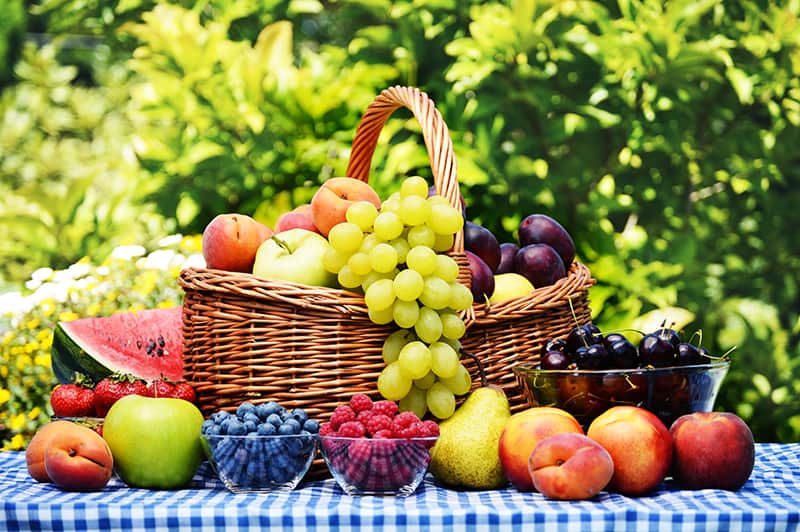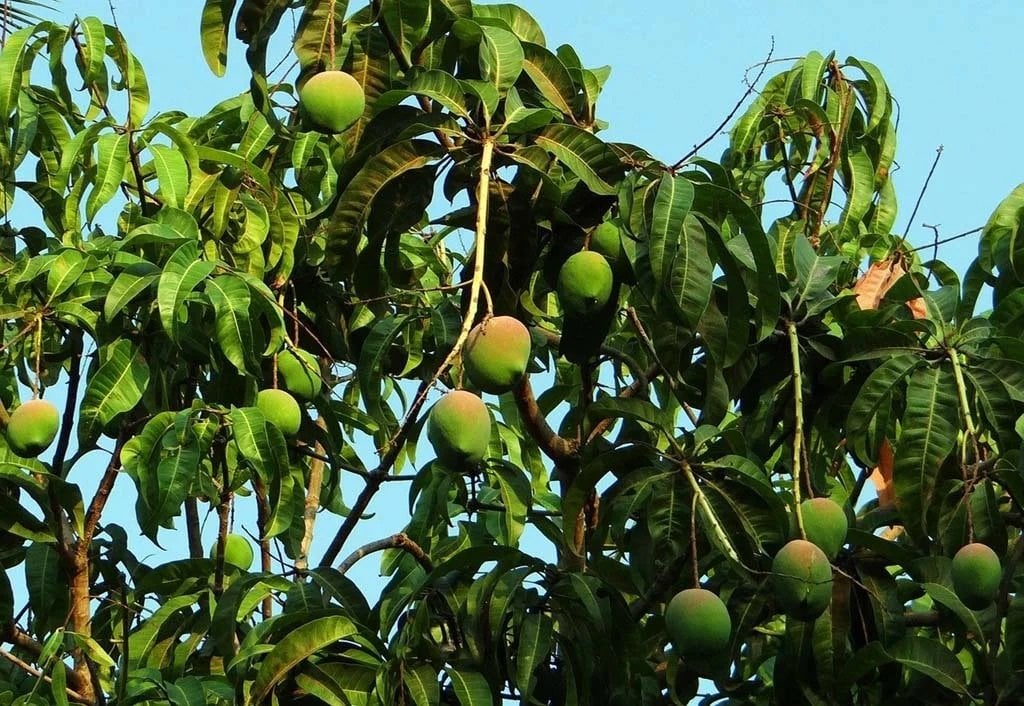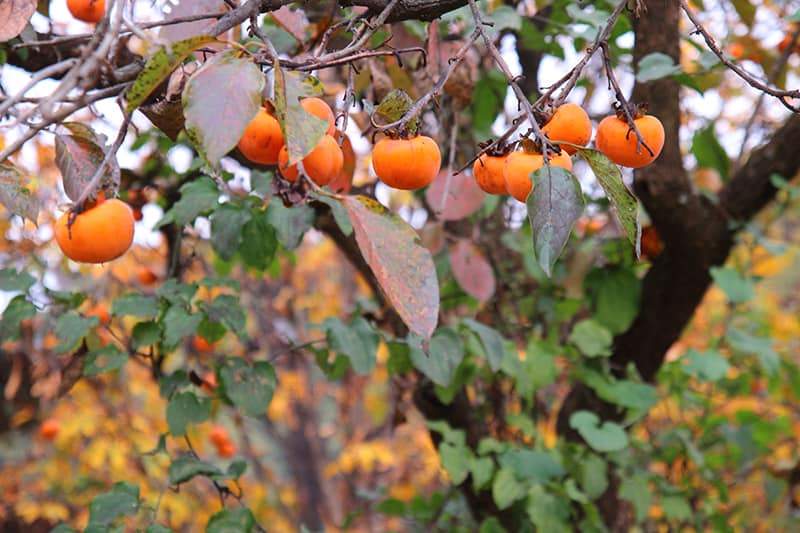- Home >
- Fruit Harvest Guide – Our Best Tips
Fruit Harvest Guide – Our Best Tips

Harvesting fresh fruit that you have grown yourself is one of the most rewarding parts of gardening. There is an uncomplicated joy in tasting fruit picked straight from the tree or gathering a plate of produce to feed your family. But knowing when to harvest your fruits is key if you’re going to enjoy them in their best condition.
If you harvest fruits too early, they will not yet have developed their full flavor and can be bitter tasting or have an unpleasant texture. If you wait too long and harvest too late, then the fruits can spoil quickly and will not keep well, and may also have poor flavor. Use this guide to learn when to harvest and get the most from your homegrown fruits.
How to Know When a Fruit is Ready to Harvest
To understand when the best time is to harvest your fruit, you need to learn how to spot a ripe fruit. Going simply by the time of the season isn’t a reliable way of deciding when to harvest because the time a fruit is ripe can vary each year depending on your climate and how the weather performed in the preceding seasons. Instead, you should learn how to determine if a fruit is ripe using your senses, such as taste and touch.
Different types of fruits might have different telltale signs of being ripe and ready for picking, but many show similar clues. Generally, fruit should not taste sour or bitter when it is ripe, though there are a few exceptions to this. To test out their flavor, select a few fruits from different areas of your tree or bush, and taste them. If they all taste ripe, then you can confidently harvest the remaining fruits on the plant. You can also check for ripeness by feeling the texture of the fruit and how firm it is. Plums should be soft when they are ready to harvest, while apples and pears should be firm.
Exceptions to these general harvesting guidelines are:
Redcurrants and acidic cherries:These will always have a sour flavor, so testing for sweetness is not necessary. Instead, you will know these fruits are ripe when they have a deep color and are soft and swollen.
Quince: Quince will always have a sour taste when first picked but will sweeten up afterward. These are best harvested as late as possible in the season, just before you are expecting the first frost.
Cooking Apples:These are sour tasting even when ripe but can be picked once windfalls start dropping. They are best left as long as possible on the tree but should be picked before frost.
Dessert Apples:If you plan to store your dessert apples, you can harvest them just before they reach optimum ripeness, and they will continue to ripen while in storage. Pick them from the tree when they are firm and crunchy.
Gooseberries:These will get sweeter the longer they stay on the bush, but if you plan to use them in cooking, then you can pick them before they are ripe.
How to Harvest Fruits
Once you have decided it is time to harvest your fruits, you’ll need to know the details of how to proceed. Here are some general tips for harvesting fruit effectively and easily.
Choose a suitable weather day
Always harvest your fruit on a dry day. If you gather fruit when it is raining, then the fruit is highly susceptible to fungal disease when it is stored. Working on harvesting your fruits during rain will also probably prove to be a miserable and soggy experience for you! Selecting a day that is not too windy will also make harvesting the fruit easier and likely lead to less dropping and wastage.
Use correct equipment
You might need special equipment, depending on the type of fruit you are harvesting. For gathering fruit from a tall tree, you can use a fruit picker with a long handle or use a step ladder and harvest the fruits by hand. Another method that will enable you to harvest fruits from a tree quickly is to lay a large sheet over the ground and then shake the branches of the tree to encourage fruit to fall off. Then you can simply roll up the sheet to gather the fruit, though this method can result in bruising and isn’t suitable for all fruits.
If you are working with crops that have thorny stems, such as raspberries or blackberries, then you should wear rubber gloves to protect your hands from cuts. You should also think about what container you want to gather fruits in; a basket works well for small fruits and berries, while a fabric or plastic bag of a fairly large size is more suitable for apples and pears.
Harvest in stages
Depending on that fruit you are harvesting, you might need to do so in stages. This is because large trees may physically take too long to harvest in one go, but also because some fruits will not all ripen at the same time. Plums are known for becoming ripe at different points, and so you should give each plum a soft squeeze to feel how soft it is, and any firm plums should be left on the tree and harvested at a later date. Apple trees will generally need to be harvested over two or three sessions to ensure the best ripeness of the picked fruit.
Know how to handle your fruit
Fruit should be handled carefully, with special attention paid to certain types. Cherries should be removed from the plant using scissors, as pulling them by hand can result in the fruits being removed from their stems. Currants should be picked while still attached to trusses and then removed individually just before you intend to use them.
Some fruits, like goji berries, can be shaken down and collected on a sheet beneath the tree. Apples and pears should easily be removed from a tree with their stalk intact by twisting the fruit. If it requires heavy force to pull it off, leave it for longer before trying again. Soft fruits, like peaches and apricots, should also come away from the tree easily. You can do this by holding the fruit in your palm and gently pressing around the stem. Again, if this does not come off the tree easily, leave it to ripen for longer.
Store fruit correctly
Harvested fruit should be used quickly or stored in an appropriate way. Berry-type fruits such as blueberries, raspberries, strawberries, blackberries, and goji berries all freeze exceptionally well. You should put them in a Ziplock bag or airtight container and freeze them soon after harvesting. They can then be used later in fruit smoothies or cooked into pies, puddings, jams, or preserves. Soft fruits like plums and nectarines do not freeze well and have a short shelf life after harvesting. They should be eaten within a few days or used in cooking. Pears can be kept in the fruit bowl for a week or two, where they will continue to ripen, while apples can be stored in the refrigerator for many weeks.
Popular Fruit Harvesting Tips
Some of the most common fruits to grow at home include strawberries, apples, and pears. Learn these useful and easy tips for home gardeners that will help to ensure your fruits are picked at the best possible time.
Strawberries
You should wait to harvest a strawberry until at least three-quarters of the skin has turned red. These strawberries will continue to ripen after they have been harvested if kept in a cool and dry place for the following few days. Strawberries that are less than half red will not continue to ripen and should be left on the plant. If you do not need your strawberries yet, leave them on the plant until they are completely red for the best flavor. Strawberries are best harvested in the morning because they are firmer at this time and less likely to sustain an injury while being picked.
Blueberries
You will know these fruits are ready to be picked when they are entirely blue-purple in color, and they come away from the plant easily. They should not need to be picked and instead should gently release themselves when you roll them in your hand. Before they are ripe, blueberries will have a red ring on the skin of the fruit, where they attach to the stem. If the red ring is still visible, the fruits should not be harvested yet.
Cherries
These fruits do not continue to ripen once picked, so they should not be harvested until you are sure they are ready. Cherries are mature when they have a deep, intense color and look plump almost to the point of bursting. Sweet cherries will have a firmer feel, while sour cherries may give a little if squeezed. Both types of cherries should come away from the plant easily with a gentle pull. Use scissors to harvest cherries to ensure the fruits remain on the stems, as this will give them several extra days of life in the fruit bowl before they spoil. To extend shelf life further, keep cherries in the refrigerator.
Cantaloupes
These melons are ripe when the netting on the skin becomes deeply grooved and more pronounced. It will also develop from a shade of green to a brown-beige shade. Cantaloupes smell sweet when they are ready to harvest, and the blossom end of the fruit should give slightly when pressed. The best test for whether a cantaloupe is ready is to gently pull it from the stem; if it comes away easily, then it is ripe, and if not, it should be left for longer.
Pears
Pears are one of the only fruits that are best picked before they are completely ripe. This is because if a pear ripens on the tree, then it will spoil after a day or two from harvesting. By comparison, if a pear is removed from a tree before being completely ripe, it will continue to ripen in the fruit bowl, and the time frame during that it is suitable for eating can be extended to a week or two. You should harvest your pears when they feel firm to the touch, and the skin color develops from green to yellow. They should then be stored in the fruit bowl to continue to ripen and are ready to eat when the neck of the pear starts to feel tender. You can store pears in the refrigerator to extend their shelf life.
Apples
There are so many different varieties of apples, and their signs of ripeness can vary. If you are growing a red or yellow variety of apple, then you will know they are ripe when their skins develop from immature green to mature red or yellow. However, some apples stay green even when mature, so skin color isn’t a guaranteed way to define ripeness. If some mature looking apples are starting to fall from the tree, then this is a good sign that the remainder of apples on the tree are ready for harvesting. The best test for any apple when it comes to ripeness is to gently tug at the fruit and see how easily it comes away from the tree. If it pulls away without pressure, then the apples are ready to harvest, and if not, then they should be left on the tree for longer.
Peaches
This is another fruit that will not continue to ripen after harvesting, and therefore should be allowed to completely ripen while on the tree. Peaches are green when immature, so a good sign that they are ripe is when their skins have transformed into a pink, orange, or yellow shade. They should be soft when ripe and should be eaten as soon as possible after being picked. Peaches deteriorate quickly, and at best, can be stored for a few days in a dry place with high humidity.










